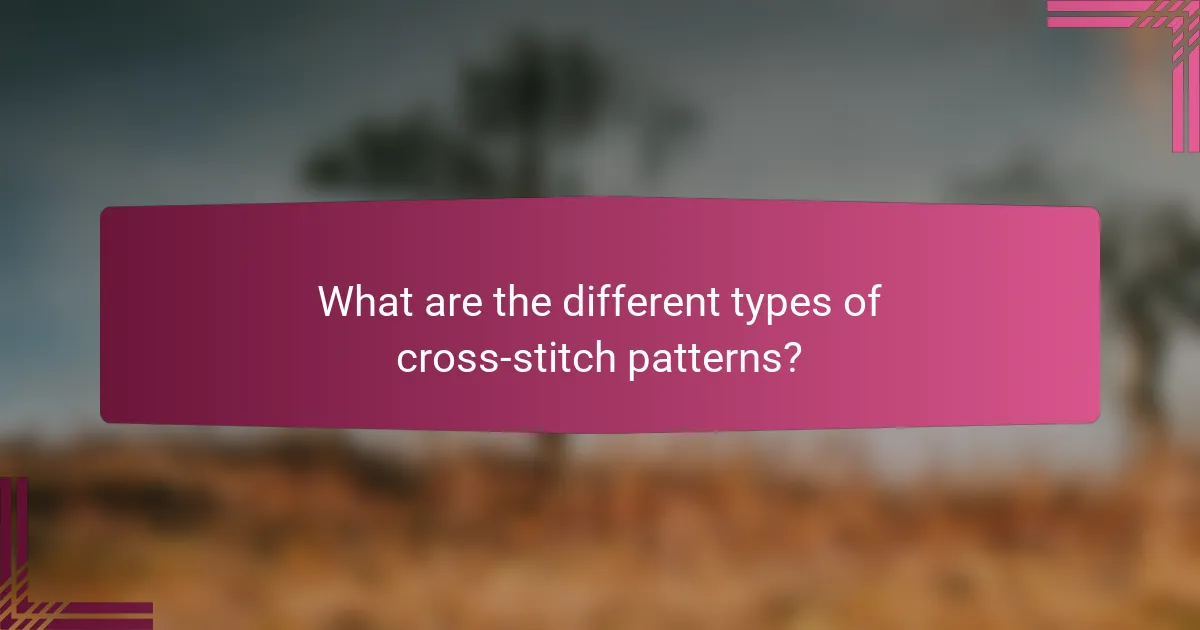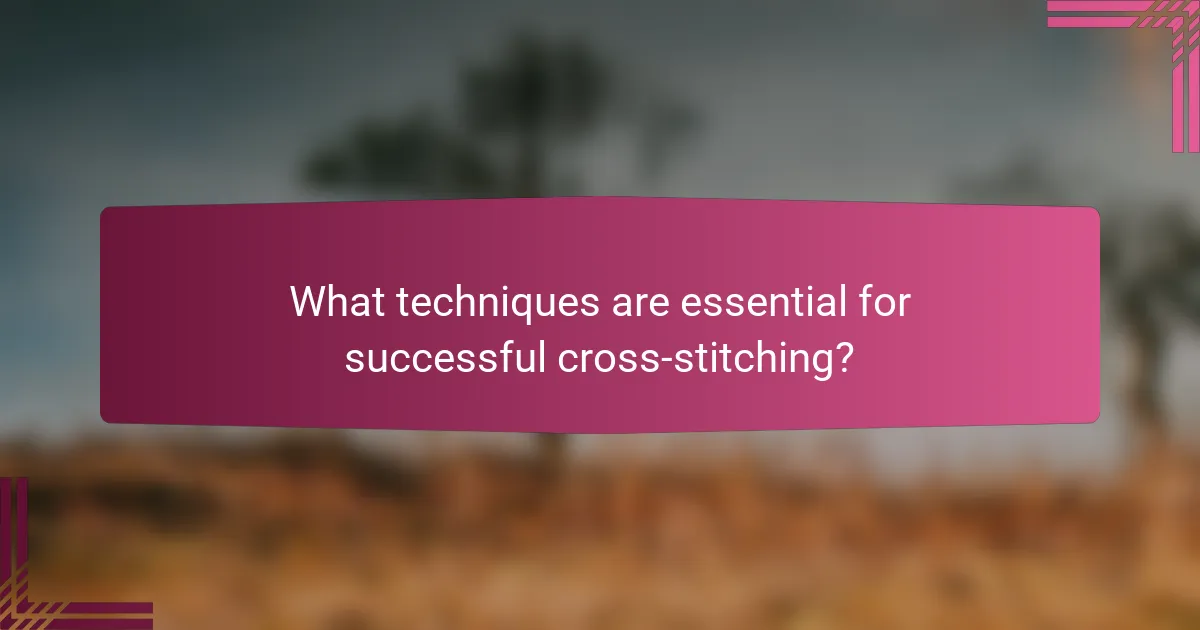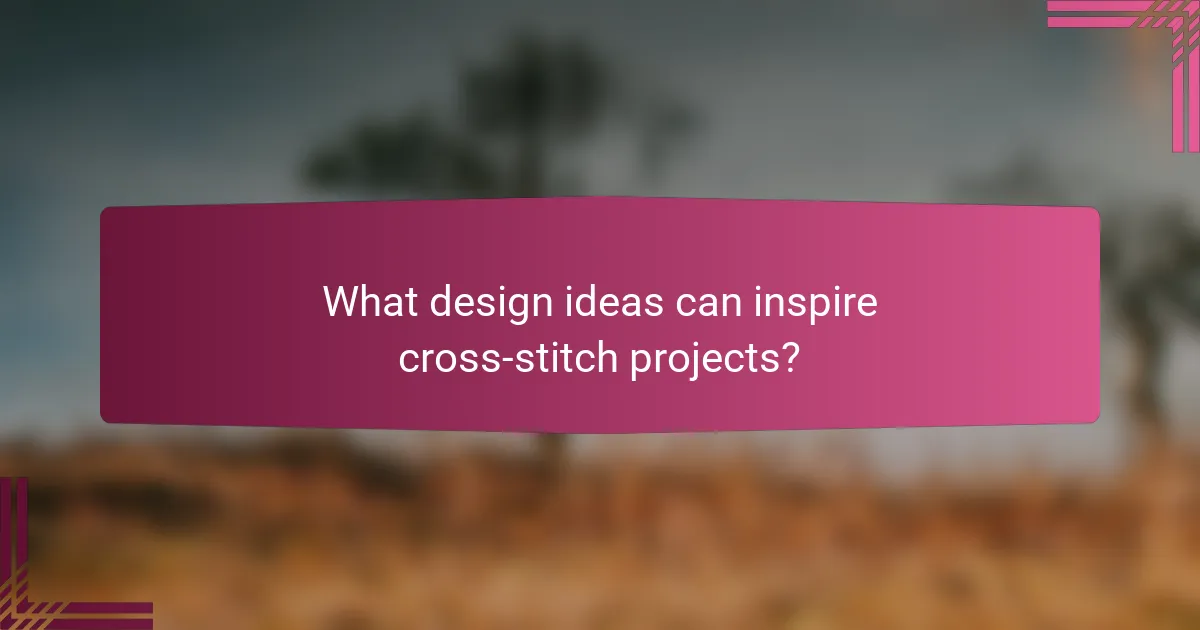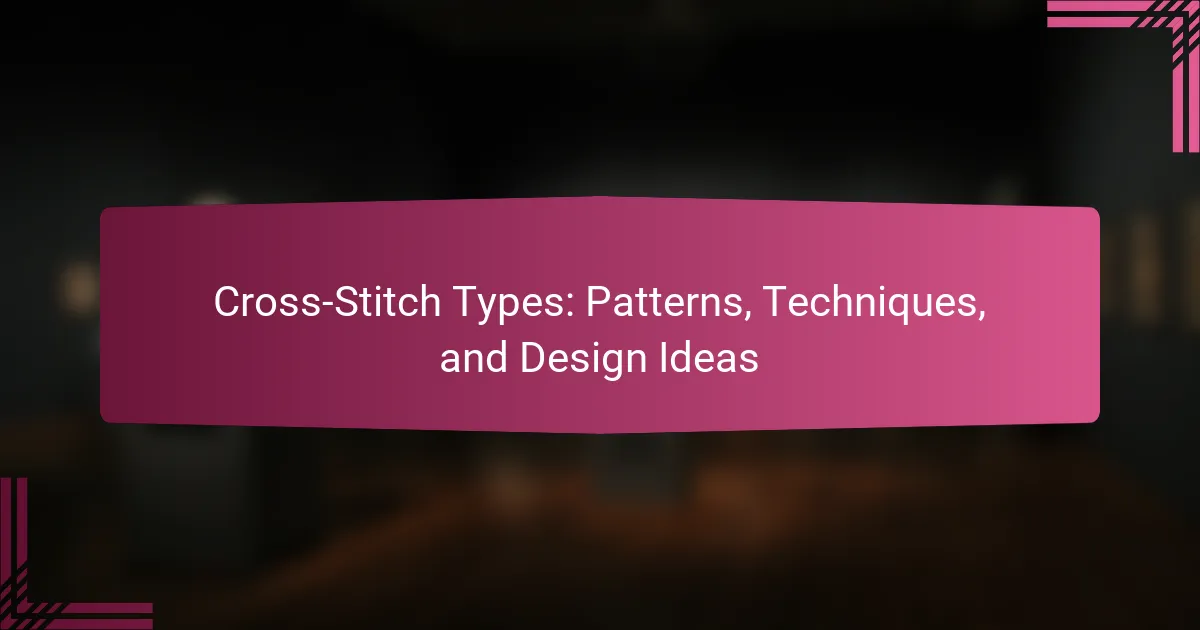
What are the different types of cross-stitch patterns?
The different types of cross-stitch patterns include counted cross-stitch, printed cross-stitch, and specialty cross-stitch. Counted cross-stitch involves following a chart to create the design. This method requires counting stitches and fabric threads. Printed cross-stitch features pre-printed designs on fabric. Crafters stitch over the printed design without counting. Specialty cross-stitch patterns include techniques like blackwork or goldwork. These patterns often incorporate unique stitches or embellishments. Each type offers distinct benefits and creative possibilities.
How do traditional patterns differ from modern designs?
Traditional patterns are characterized by intricate, repetitive designs often rooted in cultural heritage. They typically use a limited color palette and emphasize symmetry and balance. Modern designs, in contrast, embrace minimalism and experimentation with shapes and colors. They often feature abstract motifs and unconventional layouts. Traditional patterns convey historical significance and craftsmanship, while modern designs prioritize personal expression and contemporary aesthetics. The shift from traditional to modern reflects broader societal changes in art and design values.
What are the characteristics of classic cross-stitch patterns?
Classic cross-stitch patterns are defined by their distinctive grid-like structure. They typically feature a series of X-shaped stitches that create intricate designs. These patterns often utilize a limited color palette, enhancing their traditional aesthetic. Common motifs include floral designs, geometric shapes, and seasonal themes. Classic patterns are usually charted on graph paper, aiding in precise stitching. They often incorporate symmetrical layouts, which contribute to their visual balance. Many classic patterns are derived from historical designs, reflecting cultural heritage. The use of cotton or linen fabric is prevalent in these patterns, providing durability and texture.
What elements define contemporary cross-stitch designs?
Contemporary cross-stitch designs are defined by bold colors, modern patterns, and innovative techniques. They often incorporate geometric shapes and abstract motifs. Many designs reflect current trends in art and fashion. Use of unconventional materials is also common. Some contemporary pieces feature mixed media elements. High-quality threads and fabrics enhance the overall aesthetic. Digital patterns have gained popularity due to accessibility. These elements collectively contribute to a fresh and modern approach to traditional cross-stitching.
What are some popular themes in cross-stitch patterns?
Popular themes in cross-stitch patterns include floral designs, animals, and seasonal motifs. Floral designs often feature roses, daisies, and sunflowers. Animal themes can range from pets like cats and dogs to wildlife such as birds and deer. Seasonal motifs celebrate holidays and seasons, including Christmas, Halloween, and springtime scenes. Other popular themes include quotes and sayings, geometric patterns, and heritage designs. These themes cater to a wide variety of personal tastes and occasions.
How do seasonal patterns influence cross-stitch projects?
Seasonal patterns significantly influence cross-stitch projects by dictating the themes and colors used. For example, autumn patterns often feature warm hues like orange and brown, reflecting the changing leaves. Winter designs may include cool colors such as blue and white, representing snow and ice. Spring patterns typically showcase bright pastels, symbolizing blooming flowers. Summer projects often incorporate vibrant colors to depict sunny landscapes. These seasonal influences guide crafters in selecting appropriate motifs and color palettes. Additionally, seasonal patterns can enhance the relevance of a project, making it suitable for specific holidays or events. This alignment with seasons fosters creativity and engagement in cross-stitching.
What cultural motifs are commonly used in cross-stitch?
Common cultural motifs used in cross-stitch include floral designs, geometric patterns, and folk art imagery. Floral designs often represent nature and beauty, reflecting traditional styles from various cultures. Geometric patterns are prevalent in many cultures, symbolizing harmony and order. Folk art imagery showcases local traditions and stories, often featuring animals and human figures. These motifs can be traced back to historical practices in regions like Eastern Europe, Scandinavia, and the Middle East. Each motif holds cultural significance, representing the values and aesthetics of the communities they originate from.

What techniques are essential for successful cross-stitching?
Essential techniques for successful cross-stitching include proper fabric selection, accurate counting, and consistent stitching. Choosing the right fabric affects the overall appearance. Common fabrics include Aida and linen, which provide a clear grid for counting. Accurate counting ensures that stitches are placed correctly. Using a ruler or grid helps maintain precision. Consistent stitching involves maintaining even tension and following the same direction for each stitch. This creates a uniform look. Additionally, using a hoop or frame stabilizes the fabric, making stitching easier. Following these techniques leads to high-quality cross-stitch projects.
How do different stitching methods affect the final outcome?
Different stitching methods significantly influence the final outcome of cross-stitch projects. Each method alters the texture, appearance, and durability of the finished piece. For instance, full cross-stitch creates a dense and vibrant finish, while half cross-stitch results in a lighter and more delicate look. Variations like backstitching add detail and definition, enhancing the overall design. Techniques such as blending threads can introduce depth and complexity. The choice of method also impacts the time required for completion. Research shows that specific techniques can improve the longevity of the artwork, as certain stitches are more resilient to wear. Therefore, selecting the appropriate stitching method is crucial for achieving the desired aesthetic and functional qualities in cross-stitch work.
What is the difference between full cross-stitch and half cross-stitch?
Full cross-stitch and half cross-stitch are two distinct embroidery techniques. A full cross-stitch creates an ‘X’ shape using two diagonal stitches that cross at the center. This technique provides a solid and textured finish. In contrast, a half cross-stitch consists of only one diagonal stitch, resulting in a lighter and less dense appearance. The half cross-stitch is often used for shading or blending colors. Both stitches are fundamental in cross-stitching, but they serve different purposes in design and texture.
How do specialty stitches enhance cross-stitch projects?
Specialty stitches enhance cross-stitch projects by adding texture and dimension. These stitches introduce unique patterns that standard cross-stitch cannot achieve. For example, stitches like the French knot create raised elements, making designs visually appealing. Additionally, specialty stitches can mimic natural textures, such as fur or foliage. This variety enriches the overall design and engages the viewer. Incorporating specialty stitches also allows for more intricate and personalized projects. The use of these stitches can elevate simple designs into complex works of art. Overall, specialty stitches significantly improve the aesthetic quality of cross-stitch projects.
What tools and materials are necessary for cross-stitching?
The tools and materials necessary for cross-stitching include aida cloth, embroidery floss, a needle, and a hoop. Aida cloth is a fabric with a grid pattern that facilitates stitching. Embroidery floss consists of six strands of cotton thread, which can be separated for different thicknesses. A needle with a large eye is essential for threading the embroidery floss. A hoop holds the fabric taut during stitching, ensuring even tension. Additionally, scissors for trimming threads and a pattern guide for design reference are also useful. These items collectively enable effective cross-stitching.
Which fabrics are best suited for cross-stitch projects?
The best fabrics for cross-stitch projects are Aida cloth, linen, and evenweave. Aida cloth is popular for its grid-like structure, making it easy to count stitches. It comes in various counts, such as 14, 16, and 18, indicating the number of squares per inch. Linen offers a more textured surface and is favored for its durability and elegance. Evenweave fabric combines the benefits of both Aida and linen, providing a balanced thread count for precise stitching. Each fabric type allows for clear visibility of stitches, essential for accurate cross-stitching.
What types of threads are commonly used in cross-stitch?
The types of threads commonly used in cross-stitch include cotton, silk, and specialty threads. Cotton threads are the most popular choice due to their availability and wide range of colors. Silk threads offer a luxurious sheen and are often used for more intricate designs. Specialty threads, such as metallic or variegated threads, add unique textures and visual interest to projects. These threads are available in various thicknesses and can enhance the overall appearance of the finished piece.

What design ideas can inspire cross-stitch projects?
Nature themes can inspire cross-stitch projects. Floral patterns, landscapes, and animal motifs are popular choices. Geometric designs also provide a modern aesthetic. Abstract art can add a contemporary touch to projects. Seasonal themes, like holidays or weather changes, offer variety. Personalization through initials or names makes projects unique. Cultural symbols can reflect heritage and tradition. Vintage patterns often evoke nostalgia and charm.
How can personal themes be incorporated into cross-stitch designs?
Personal themes can be incorporated into cross-stitch designs by selecting motifs that reflect individual interests or experiences. Customizing patterns with personal symbols, such as initials or favorite quotes, enhances the emotional connection. Using color palettes that resonate with personal memories can further personalize the design. Additionally, incorporating images of significant places or events can create a narrative within the artwork. Many crafters use software to create unique patterns from personal photographs. This approach ensures that each piece tells a personal story. Overall, personal themes transform cross-stitch from a craft into a meaningful expression of individuality.
What are some ways to customize patterns for unique projects?
To customize patterns for unique projects, you can alter colors, adjust sizes, and modify design elements. Changing colors can create different moods or themes in your project. Adjusting sizes allows for personalization, making patterns fit specific dimensions. Modifying design elements, such as adding or removing motifs, tailors the pattern to your vision. Incorporating personal symbols or initials can enhance uniqueness. Using software tools for digital patterns offers flexibility in customization. Experimenting with different fabrics can also affect the final look. Each of these methods contributes to a distinct and personalized cross-stitch project.
How can cross-stitch be used to create personalized gifts?
Cross-stitch can be used to create personalized gifts by allowing crafters to customize designs for recipients. Crafters can choose specific patterns that reflect the recipient’s interests or hobbies. Names, dates, or meaningful quotes can be incorporated into the designs for added personalization. Various color schemes can be selected to match the recipient’s preferences. Finished cross-stitch pieces can be framed, turned into pillows, or made into wall hangings. This craft adds a personal touch that store-bought gifts often lack. The effort and time invested in cross-stitching demonstrate thoughtfulness and care. Personalized gifts made through cross-stitch are often cherished keepsakes.
What are some tips for beginners in cross-stitching?
Start with a simple pattern. Beginners should choose easy designs to build confidence. Use quality materials like embroidery floss and aida cloth. This ensures a better experience and outcome. Practice basic stitches consistently. Mastering the cross stitch is essential for progress. Keep your workspace organized. An uncluttered area helps focus on the task. Use a hoop to maintain tension. This technique prevents fabric distortion. Finally, refer to online tutorials or guides. They provide valuable visual instructions and tips.
What common mistakes should beginners avoid in cross-stitch?
Beginners in cross-stitch should avoid several common mistakes. One mistake is not counting threads accurately. Incorrect counting can lead to misalignment in the design. Another mistake is using the wrong fabric type. Aida cloth is recommended for beginners due to its clear grid. Beginners often overlook the importance of proper tension. Uneven tension can cause puckering in the finished piece. Additionally, beginners may neglect to secure their threads properly. This can result in loose stitches and unraveling. Lastly, starting without a clear plan or pattern can lead to confusion. Following a specific pattern helps ensure a successful project.
How can beginners choose the right patterns to start with?
Beginners can choose the right cross-stitch patterns by selecting simple designs with fewer colors and stitches. Starting with basic shapes, such as hearts or flowers, helps in mastering techniques. Patterns labeled as “beginner” often include clear instructions and diagrams. Choosing patterns with a lower stitch count ensures manageable projects. Additionally, beginners should consider their interests, as personal motivation enhances enjoyment. Online platforms often provide user reviews, which can guide selection. Following these guidelines increases the likelihood of a successful and enjoyable cross-stitch experience.
The main entity of the article is cross-stitch, which encompasses various types of patterns, techniques, and design ideas. The article categorizes cross-stitch patterns into counted, printed, and specialty types, highlighting their unique attributes and benefits. It contrasts traditional and modern designs, discusses popular themes, and outlines essential techniques for successful stitching. Additionally, it provides insights on tools, materials, and customization options for creating personalized projects, along with tips for beginners to enhance their cross-stitching experience.
